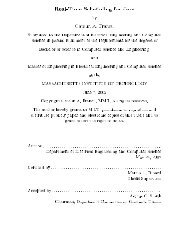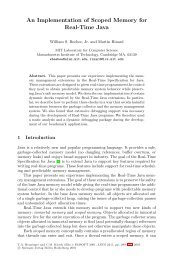HID Usage Tables Document 1.1 - C. Scott Ananian
HID Usage Tables Document 1.1 - C. Scott Ananian
HID Usage Tables Document 1.1 - C. Scott Ananian
- No tags were found...
Create successful ePaper yourself
Turn your PDF publications into a flip-book with our unique Google optimized e-Paper software.
Universal Serial Bus <strong>HID</strong> <strong>Usage</strong> <strong>Tables</strong> 5Page ID Page Name Section or <strong>Document</strong>91 Arcade Page OAAF Definitions for arcade andcoinop related Devices92-FEFFFF00-FFFFReservedVendor-definedA bold usage definition in the following sections identifies a collection. Non-bold definitions are specificfeatures related to a device that would be applied to individual controls that generate data. In many cases,specific usages can be used by a number of device types.3.1 <strong>HID</strong> <strong>Usage</strong> Table Conventions<strong>Usage</strong> ID 0 should always be reserved.<strong>Usage</strong> ID 1 through 0x1F are reserved for “top level” collections. These usage IDs are not necessarilyapplication-level but are used to identify general device types.<strong>Usage</strong> page values are limited to 16 bits.<strong>Usage</strong> ID values are limited to 16 bits.<strong>Usage</strong>s are 32-bit identifiers, where the high order 16 bits represents the usage page and the low order 16bits represents the usage ID. To allow more compact Report descriptors, <strong>Usage</strong> Page items can be declaredto specify the high order bits of the <strong>Usage</strong> item and the <strong>Usage</strong> items can declare only the ID portion of theusage, as follows:• If the bSize field of the <strong>Usage</strong> item equals 1 or 2, the entire 1- or 2-byte data portion of the item isinterpreted as a usage ID.• If the bSize field equals 3, bits 16-31 of the 4-byte data portion of the item are interpreted as a usagepage, and bits 0-15 of the data portion are interpreted as a usage ID. This interpretation of usagesapplies to <strong>Usage</strong>, <strong>Usage</strong> Minimum, and <strong>Usage</strong> Maximum items.The notation for a 32-bit usage (sometimes called an extended usage) in the examples is<strong>Usage</strong>(<strong>Usage</strong> Page: <strong>Usage</strong> ID).3.2 Handling Unknown <strong>Usage</strong>sIf a usage is unknown to an application then the application should ignore it.If the usage attached to a collection is unknown to an application, then the application should ignore thecollection and all usages contained in the collection. A collection can be used to modify the meaning of theusages that it contains, therefore “known” usages within an unknown collection may not represent theiroriginal meaning. An example of this is the <strong>Usage</strong> Selected Indicator on the LED page.System software provides capabilities for parsing <strong>HID</strong> Report descriptors. In some cases the usageassociated with the top level application collection can be used by the system software as a key to load anapplication-specific driver or a mapping driver for legacy compatibility.3.3 <strong>Usage</strong>s and UnitsFor usages that declare data items as a measurement of time, distance, force, and so forth, an applicationmust look at the units to properly interpret the value defined by a usage, unless:1. The usage specifically declares Units as optional.Version <strong>1.1</strong> April 8, 1999





